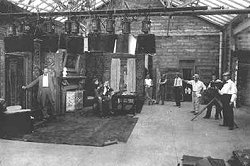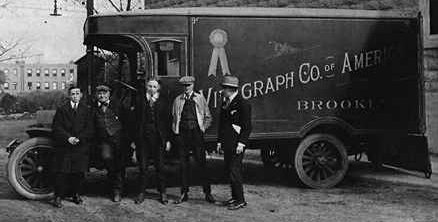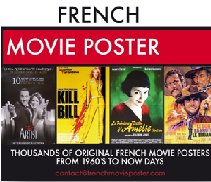In
1896, J. Stuart Blackton, Albert E. Smith and Ronald A. Reader, three
Englishmen had their vaudeville act cancelled and were looking for
other jobs. Blackton, a moonlighting reporter/cartoonist for the New
York Evening World, was sent to interview Thomas Edison about his
new film projector. He and Edison hit it off when Blackton did some
sketches of him, so much so, that Edison asked Blackton to do some
of his drawings for the motion picture camera. He did, and as a result
of Blackton's exposure to this new means of making money, the three
Englishmen purchased a projecting machine and 10 films from Edison
for $800.
A
year later they founded the American Vitagraph Company, in direct
competition with Edison, with some sources claiming Reader as a silent
partner. Reader became the projectionist as they tried to continue
their vaudeville acts, but with the addition of motion pictures showing
any type of movement such as trains, clouds or people walking.
The
vaudeville act was popular for a while but quickly was outdated. The
Englishmen decided to go into newsreels.
They
sent cameramen to film events from the Spanish-American War of 1898.
Unfortuately, they weren't able to film the battle. So in desperation,
they created re-enactments and passed off the footage as actual events
becoming the first propaganda films. ("The Battle of Santiago
Bay" was filmed in an improvised bathtub, with the "smoke
of battle" provided by Mrs. Blackton's cigarette).
However,
they did document several major events such as: the Galveston flood
of 1900, the 1901 assassination of President McKinley, the 1904 inauguration
of President Theodore Roosevelt and the aftermath of the 1906 San
Francisco earthquake. They were present at the first successful flight
by the Wright Brothers Dec. 14, 1903, at Kitty Hawk, N.C., but failed
to get pictures because of their skepticism once they saw the Wright
Brothers' "fool contraption."
During
this time, a final partner, distributor William "Pop" Rock,
was added around the turn of the century. Rock, also an Englishman,
had purchased a projector and films from Edison and had been touring
the country showing films at outdoor fairs. His claim to fame was
that in April 1896, he came to New Orleans, Louisiana for an outdoor
fair. The location was a huge blank field in Gentilly with no electricity.
He paid a local engineer to run a powerline from the streetcar which
stopped close by. He projected the films on a large canvas erected
in the field. It was so popular that he rented an empty building on
Canal Street in downtown New Orleans and had 400 seats installed.
On
June 26, 1896, 'Pop' Rock opened the first indoor theater opened expressly
for the purpose of showing films. It was called "Vitascope Hall".
(Unfortunately now it's a Burger King and the site is not even marked)
Rock,
20 years older than the others, became the President, Smith as treasurer
and Blackton as secretary in the new partnership.
 In
1904, they established a studio in the Flatbush neighborhood of Brooklyn,
NY. (shown on the left) and opened a film office in Chicago, Illinois.
In
1904, they established a studio in the Flatbush neighborhood of Brooklyn,
NY. (shown on the left) and opened a film office in Chicago, Illinois.
By
1906, they were so successful with foreign operations that Vitagraph
opened offices in London, Paris and Berlin in 1908.
Blackton
did his best to avoid lawsuits by buying a special license from Edison
and by agreeing to sell many of his most popular films to Edison for
distribution.

Vitagraph
joined Edison in forming the Motion Pictures Patent Company (MPPC).
In
1910, Vitagraph sent its first permanent company to California and
claimed such actors as Broncho Billy Anderson, Annette Kellerman,
Paul Panzer, Florence Lawrence (the Vitagraph Girl), Florence Turner,
Maurice Costello, Gladys Hulette, Julia Swayne Gordon and many others.
One of their most successful series of films was the "Happy Hooligan"
comedies about a tramp in which J. Stuart Blackton played the lead.
(sound familiar?)
In
1913, Vitagraph bought out Star Films, which was the US branch
of Melies
Studios from France with the only complete sets of Melies
films.
The
company made two "superproductions" in late 1913, early
1914 "A Million Dollar Bid" at five reels and "The
Christian" at eight reels. Theaters were reluctant to show any
films that long claiming the public would not sit through a film lasting
more than an hour.
Convinced
that the public wanted better films, they leased the Criterion
Theatre on Broadway in New York, renamed it the Vitagraph Theatre,
and opened it Feb. 7, 1914, becoming the first producers to exhibit
their own films. It was so successful that they started leasing
others. Exhibitors were outraged and demanded that they stop or
they would stop showingVitagraph films. Vitagraph agreed and stopped,
but the idea was planted with what would become the industry standard
in years to come of studios owning their own theaters.
Early
in 1916, Vitagraph bought VSLE Distributors to expand their distribution.
Vitagraph
grew by leaps and bounds with the purchase of Kalem
Studios and all their roster in 1916.
Later
that year things began to change with the death of 'Pop' Rock . Without
the leadership of Rock, Blackton decided to resign to go into independant
production. Blackton went back to England and tried to produce films
there.
In
1919, Vitagraph struggled with General Film Company closing and the
foreign markets gone due to the war.
In
the early twenties, the company felt the effects of the bigger
film companies who were emerging, buying up theatres across the
country and releasing more and bigger pictures than Vitagraph.
In
1923, Blackton came back from England to help and became full partner
again. With Smith as the head and Blackton creating, the company stabilized
and stayed solvent.
In
1925, the estimated value of Vitagraph was $4.2 million with no indebtedness.
However, that same year, ready to retire, Smith reached an agreement
with Warner Brothers to purchase Vitagraph for $735,000 which was
split equally between Smith, Blackton and "Pop" Rock's son.
Warner
Brothers convinced Smith to stay on, however, as chairman of the
board of Vitagraph.
Warner
Brothers also bought the sound system from Western Electric later
that year. The Brooklyn studio was used to fom the Vitaphone Corp.
which would work on adding sound to film.
Vitagraph
was turned into the distribution arm of Warner Brothers.
Films
in our database by Vitagraph





